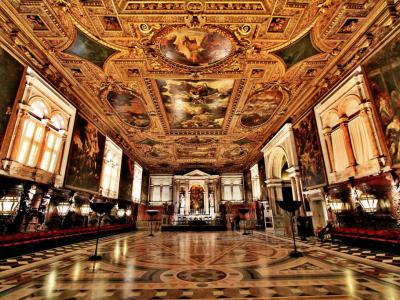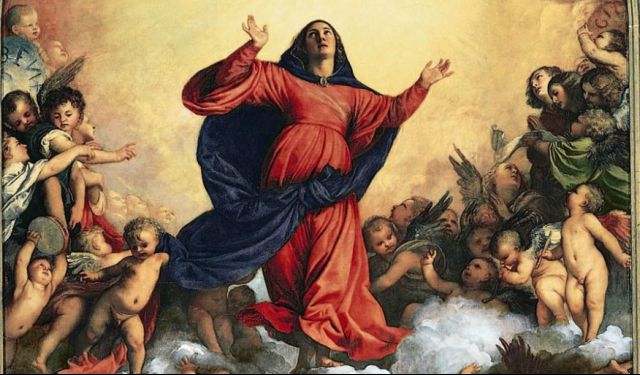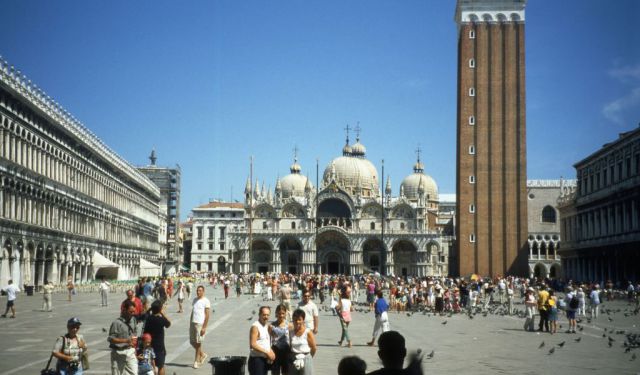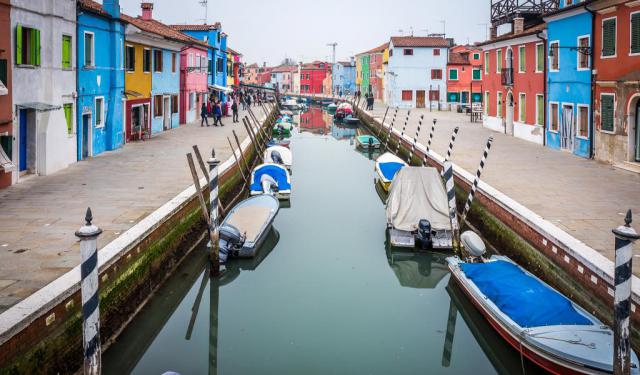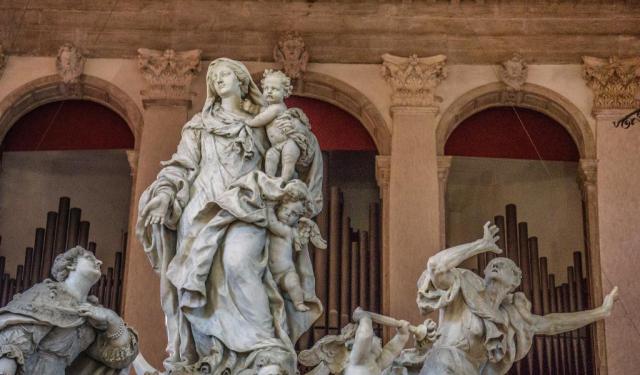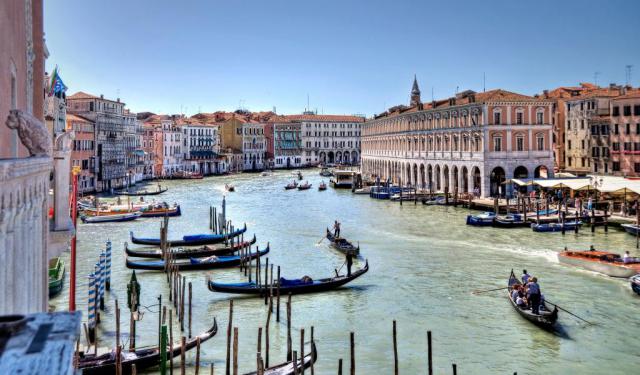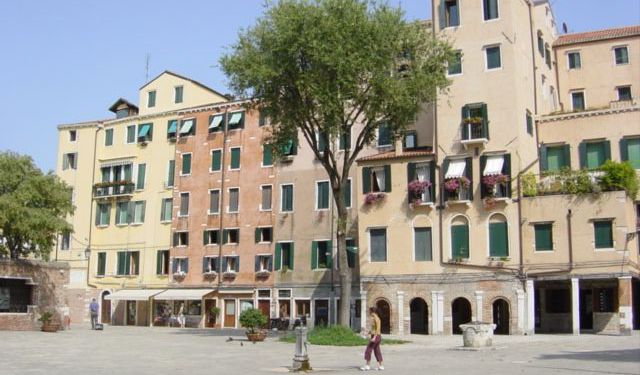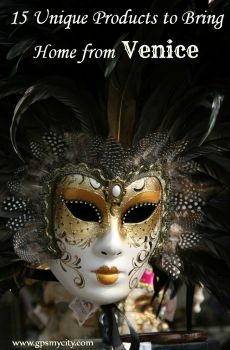Scuola Grande di San Rocco (Great School of St. Roch), Venice (must see)
The religious fraternity ("scuola") of Saint Roch was set up in Venice in 1478. Seven years later, the saint's remains were brought from Germany, resulting in a surge of donations so great that in 1489, the fraternity attained the status of a "Scuola Grande". In 1527, the city was struck by a plague outbreak, causing the scuola's revenue to skyrocket as people desperately sought Saint Roch's protection from the disease. The funds generated eventually financed the construction of the current building, complete with the remarkable paintings inside.
Indeed, no other Venetian fraternity is as lavishly decorated as this one. The artist responsible for its decoration is Venice's own 16th-century painter, Tintoretto. Born Jacopo Robusti, he acquired his nickname, which means "little dyer" or "dyer's boy", due to his father's profession as a dyer ("tintore"). Also known as Il Furioso ("The Furious") for his phenomenal energy in painting, Tintoretto was both admired and criticized by his contemporaries for the unprecedented boldness of his brushwork and his incredible speed. Nonetheless, it took him three decades to complete this project, starting at the age of 46 and continuing until his death in 1594 at the age of 76.
During this time, Tintoretto created over 50 epic canvases for the walls and ceilings of the Scuola Grande, earning it high praise from critics as "one of the three most precious buildings in Italy" due to its overwhelming impact. While the Tintoretto cycle begins with the "Annunciation" in the lower room, to truly appreciate his artistic progression, it is best to start in the smaller room on the upper floor, known as the Sala dell'Albergo, which houses the "Crucifixion" painting, showcasing the full magnitude of Tintoretto's mastery.
Other notable highlights include the New Testament scenes in the main upper hall, which defy conventions of perspective, lighting, and color-a testament to Tintoretto's relentless inventiveness that has few parallels in Western art. Despite being in his late 60s when he painted these scenes, they are considered some of his finest creations.
Why You Should Visit:
Rarely busy or crowded, offering a peaceful oasis of culture and Venetian history.
Photos do not do justice to the overwhelming experience of seeing it in person.
Tip:
Don't forget to pick up an audio guide since there are no descriptions available.
Dress warmly as it can get quite cold inside, and don't forget to bring your camera.
Take advantage of the mirrors in the chapter room to study the ceiling art without straining your neck.
Indeed, no other Venetian fraternity is as lavishly decorated as this one. The artist responsible for its decoration is Venice's own 16th-century painter, Tintoretto. Born Jacopo Robusti, he acquired his nickname, which means "little dyer" or "dyer's boy", due to his father's profession as a dyer ("tintore"). Also known as Il Furioso ("The Furious") for his phenomenal energy in painting, Tintoretto was both admired and criticized by his contemporaries for the unprecedented boldness of his brushwork and his incredible speed. Nonetheless, it took him three decades to complete this project, starting at the age of 46 and continuing until his death in 1594 at the age of 76.
During this time, Tintoretto created over 50 epic canvases for the walls and ceilings of the Scuola Grande, earning it high praise from critics as "one of the three most precious buildings in Italy" due to its overwhelming impact. While the Tintoretto cycle begins with the "Annunciation" in the lower room, to truly appreciate his artistic progression, it is best to start in the smaller room on the upper floor, known as the Sala dell'Albergo, which houses the "Crucifixion" painting, showcasing the full magnitude of Tintoretto's mastery.
Other notable highlights include the New Testament scenes in the main upper hall, which defy conventions of perspective, lighting, and color-a testament to Tintoretto's relentless inventiveness that has few parallels in Western art. Despite being in his late 60s when he painted these scenes, they are considered some of his finest creations.
Why You Should Visit:
Rarely busy or crowded, offering a peaceful oasis of culture and Venetian history.
Photos do not do justice to the overwhelming experience of seeing it in person.
Tip:
Don't forget to pick up an audio guide since there are no descriptions available.
Dress warmly as it can get quite cold inside, and don't forget to bring your camera.
Take advantage of the mirrors in the chapter room to study the ceiling art without straining your neck.
Want to visit this sight? Check out these Self-Guided Walking Tours in Venice. Alternatively, you can download the mobile app "GPSmyCity: Walks in 1K+ Cities" from Apple App Store or Google Play Store. The app turns your mobile device to a personal tour guide and it works offline, so no data plan is needed when traveling abroad.
Scuola Grande di San Rocco (Great School of St. Roch) on Map
Sight Name: Scuola Grande di San Rocco (Great School of St. Roch)
Sight Location: Venice, Italy (See walking tours in Venice)
Sight Type: Attraction/Landmark
Guide(s) Containing This Sight:
Sight Location: Venice, Italy (See walking tours in Venice)
Sight Type: Attraction/Landmark
Guide(s) Containing This Sight:
Walking Tours in Venice, Italy
Create Your Own Walk in Venice
Creating your own self-guided walk in Venice is easy and fun. Choose the city attractions that you want to see and a walk route map will be created just for you. You can even set your hotel as the start point of the walk.
Titian's Paintings Walk
One of the greatest painters of all time, Tiziano Vecelli – better known as Titian – was a pioneering figure of the Venetian school of Italian Renaissance painting. His career was successful from the start, and he became sought after by patrons, initially from Venice and its possessions, then joined by the north Italian princes, and finally the Habsburgs and papacy.
Equally adept with... view more
Tour Duration: 2 Hour(s)
Travel Distance: 3.6 Km or 2.2 Miles
Equally adept with... view more
Tour Duration: 2 Hour(s)
Travel Distance: 3.6 Km or 2.2 Miles
Piazza San Marco Walking Tour
All of Venice’s roads seem to run into Piazza San Marco – the commercial, religious, and political heart of the city. With a glowing reputation as one of the finest squares in the world and arguably one of Europe’s primary tourist attractions, it certainly has a lot to offer to visitors.
Start your exploration with a tour of the pink-and-white marble Palazzo Ducale, which takes you... view more
Tour Duration: 1 Hour(s)
Travel Distance: 0.6 Km or 0.4 Miles
Start your exploration with a tour of the pink-and-white marble Palazzo Ducale, which takes you... view more
Tour Duration: 1 Hour(s)
Travel Distance: 0.6 Km or 0.4 Miles
Murano Island Walking Tour
Murano is often called the Glass Island, since it is home to the most impressive and renowned Venetian glass factories. The master craftsmen here have preserved their centuries-old techniques, and the island is full of shops where you can admire and purchase their adorable glass items. Some factories, such as Gino Mazzuccato’s, at the start of this self-guided walk, even have special showrooms... view more
Tour Duration: 1 Hour(s)
Travel Distance: 2.3 Km or 1.4 Miles
Tour Duration: 1 Hour(s)
Travel Distance: 2.3 Km or 1.4 Miles
Venice's Hidden Art Treasures
Among the first things springing to mind when talking about Venice, apart from the canals and gondolas, of course, is Art and Architecture. Indeed, Venice is one of the few cities in the world where Art and Architecture have merged in a stunning multiplicity of forms. The city is even renowned for its unique (Venetian) pictorial school famed by the likes of Tintoretto, Titian, Veronese, Castagno... view more
Tour Duration: 2 Hour(s)
Travel Distance: 3.6 Km or 2.2 Miles
Tour Duration: 2 Hour(s)
Travel Distance: 3.6 Km or 2.2 Miles
Venice Introduction Walking Tour
Although most experts agree that the Venetian lagoon emerged nearly 6,000 years ago, the area of today's Venice remained mostly uninhabited, except for a small population of fishermen, up until the 5th century AD when the hordes of Gothic barbarians, looting their way into Rome, drove many a people away from their homes on the mainland to take refuge on the coastal Venetian islands.
Those... view more
Tour Duration: 3 Hour(s)
Travel Distance: 4.1 Km or 2.5 Miles
Those... view more
Tour Duration: 3 Hour(s)
Travel Distance: 4.1 Km or 2.5 Miles
Jewish Ghetto Tour
Founded in 1516, the Jewish Ghetto in Venice was the oldest of its kind in all Europe. At the time, Venice received order from the Pope to expel all Jews from the city, but the Venetian government opted to lock them onto a small island in the district of Cannaregio. Since then this small area has been the center of Jewish life in Venice, with buildings rising vertically to accommodate the rising... view more
Tour Duration: 1 Hour(s)
Travel Distance: 0.4 Km or 0.2 Miles
Tour Duration: 1 Hour(s)
Travel Distance: 0.4 Km or 0.2 Miles
Useful Travel Guides for Planning Your Trip
15 Distinctively Italian Things to Buy in Venice
Venice has been a tourist mecca for over a century now, with millions of visitors flocking in every year to see this unique place on the face of the Earth. Many, if not all, of these people seek to obtain something memorable as a token of their stay in this city. By far, not all of them know which...
